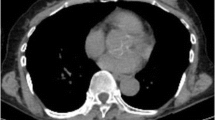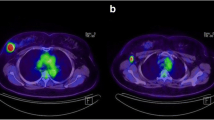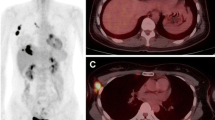Abstract.
The aim of this study was to evaluate the possible correlation between preoperative FDG-PET results in human breast cancer and the prognostic markers Ki-67, c-erb B2, p53, oestrogen/progesterone receptor status, axillary lymph node status, tumour size and tumour grading. Seventy-five female patients with breast cancer were included in this prospective study. Patient selection was independent of tumour size and the suspected clinical stage of disease. A high-resolution full-ring scanner (Siemens ECAT HR+) was used for PET imaging. The FDG uptake of breast tumours was calculated as the tumour to background ratio (TBR). In resected cancer tissue specimens, the proliferative fraction was evaluated by Ki-67 immunostaining. Additionally, immunostaining of the prognostic markers c-erb B2, p53, and progesterone and oestrogen receptors was performed. Haematoxylin and eosin-stained sections were used for tumour grading. Correlations between FDG uptake and prognostic markers were assumed to be significant at P<0.05 using the Mann-Whitney U test. In ductal breast cancer, mean TBR was 17.3 (median 7.7, range 1.6–122.7), while in lobular cancer it was 6.5 (median 3.7, range 1.4–22.7). Mean proliferative fraction (% Ki-67 positive tumour cells) was 15%±13.8% (median 10%, range 0%–60%). Twenty-three carcinomas showed <5% Ki-67 positive tumour cells. Statistical analysis indicated a positive correlation between FDG uptake and proliferative index in ductal breast cancer (P<0.0001, r=0.63). By contrast, there was no correlation between FDG uptake and c-erb B2 (P=0.79), p53 (P=0.92), tumour grading (P=0.09), oestrogen receptor status (P=0.41), progesterone receptor status (P=0.34), axillary lymph node status (P=0.90) and tumour size (P=0.3). It is concluded that FDG uptake is significantly higher in ductal breast cancer than in lobular cancer (P<0.05). FDG uptake correlates with proliferative activity assessed by Ki-67 immunostaining (P<0.05). A significant correlation with the other prognostic markers, however, could not be demonstrated.
Similar content being viewed by others
Author information
Authors and Affiliations
Additional information
Received 5 January and in revised form 7 May 2002
Electronic Publication
Rights and permissions
About this article
Cite this article
Buck, A., Schirrmeister, H., Kühn, T. et al. FDG uptake in breast cancer: correlation with biological and clinical prognostic parameters. Eur J Nucl Med 29, 1317–1323 (2002). https://doi.org/10.1007/s00259-002-0880-8
Published:
Issue Date:
DOI: https://doi.org/10.1007/s00259-002-0880-8




